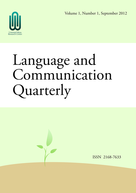


Volume 13 Issues 1-2 (2024-06-30)
Volume 10 Issues 1-4 (2021-12-31)
Volume 9 Issues 1-4 (2020-12-31)
Volume 8 Issues 1&2 (2019-06-30)
Volume 7 Issues 3&4 (2018-12-31)
Volume 7 Issues 1&2 (2018-06-30)
Volume 6 Issues 3&4 (2017-12-31)
Volume 6 Issues 1&2 (2017-06-30)
Volume 5 Issues 3&4 (2016-12-31)
Volume 5 Issues 1&2 (2016-06-30)
Volume 4 Issues 3&4 (2015-12-31)
Languages and the words are the gate of the minds to compose political speeches. Football has a long history of its relation with politics. To change a football in a nation, we need a transformational leader which promotes political participation. A transformational leader is someone who makes a similar language to the followers. This study uses word frequency analysis to know the similarity of the language between a leader and the followers on a micro-blogging platform. The results strengthen the similarity of both sides. But, the leader tends to actively do political communication only during political events.
Using semi-structured interviews, this study examined six K-12 classroom teachers’ perceptions of the impact of intercultural miscommunication on ESL students’ learning, the major causes of intercultural miscommunication, and strategies for teachers to help ESL students avoid intercultural miscommunication and develop intercultural communicative competence. The results show that intercultural miscommunication affects ESL students’ understanding of American culture and communication with their teachers and peers at schools. It also affects their learning in the classroom. Intercultural miscommunication occurs because of the diversity of cultural meanings embedded in words for communication, the presence of a language barrier in ESL students and their failure to understand common cultural cues, and their lack of exposure to various cultures and expressions as well as their lack of understanding of the way language is utilized for varying purposes. Important educational implications are discussed.